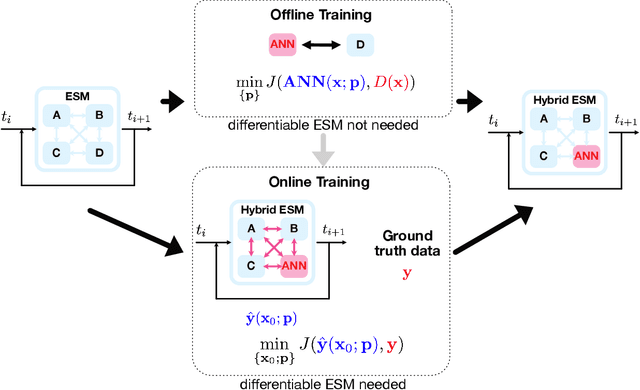Sebastian Bathiany
Deep Learning for predicting rate-induced tipping
Sep 11, 2024Abstract:Nonlinear dynamical systems exposed to changing forcing can exhibit catastrophic transitions between alternative and often markedly different states. The phenomenon of critical slowing down (CSD) can be used to anticipate such transitions if caused by a bifurcation and if the change in forcing is slow compared to the internal time scale of the system. However, in many real-world situations, these assumptions are not met and transitions can be triggered because the forcing exceeds a critical rate. For example, given the pace of anthropogenic climate change in comparison to the internal time scales of key Earth system components, such as the polar ice sheets or the Atlantic Meridional Overturning Circulation, such rate-induced tipping poses a severe risk. Moreover, depending on the realisation of random perturbations, some trajectories may transition across an unstable boundary, while others do not, even under the same forcing. CSD-based indicators generally cannot distinguish these cases of noise-induced tipping versus no tipping. This severely limits our ability to assess the risks of tipping, and to predict individual trajectories. To address this, we make a first attempt to develop a deep learning framework to predict transition probabilities of dynamical systems ahead of rate-induced transitions. Our method issues early warnings, as demonstrated on three prototypical systems for rate-induced tipping, subjected to time-varying equilibrium drift and noise perturbations. Exploiting explainable artificial intelligence methods, our framework captures the fingerprints necessary for early detection of rate-induced tipping, even in cases of long lead times. Our findings demonstrate the predictability of rate-induced and noise-induced tipping, advancing our ability to determine safe operating spaces for a broader class of dynamical systems than possible so far.
Differentiable Programming for Earth System Modeling
Aug 29, 2022

Abstract:Earth System Models (ESMs) are the primary tools for investigating future Earth system states at time scales from decades to centuries, especially in response to anthropogenic greenhouse gas release. State-of-the-art ESMs can reproduce the observational global mean temperature anomalies of the last 150 years. Nevertheless, ESMs need further improvements, most importantly regarding (i) the large spread in their estimates of climate sensitivity, i.e., the temperature response to increases in atmospheric greenhouse gases, (ii) the modeled spatial patterns of key variables such as temperature and precipitation, (iii) their representation of extreme weather events, and (iv) their representation of multistable Earth system components and their ability to predict associated abrupt transitions. Here, we argue that making ESMs automatically differentiable has huge potential to advance ESMs, especially with respect to these key shortcomings. First, automatic differentiability would allow objective calibration of ESMs, i.e., the selection of optimal values with respect to a cost function for a large number of free parameters, which are currently tuned mostly manually. Second, recent advances in Machine Learning (ML) and in the amount, accuracy, and resolution of observational data promise to be helpful with at least some of the above aspects because ML may be used to incorporate additional information from observations into ESMs. Automatic differentiability is an essential ingredient in the construction of such hybrid models, combining process-based ESMs with ML components. We document recent work showcasing the potential of automatic differentiation for a new generation of substantially improved, data-informed ESMs.
 Add to Chrome
Add to Chrome Add to Firefox
Add to Firefox Add to Edge
Add to Edge